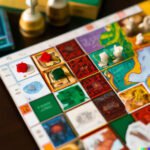The Board Game of Thrones has captivated fans around the world with its thrilling gameplay and complex strategy. With each player representing a different house vying for control over Westeros, understanding the intricacies of the game’s strategy is crucial for success. In this article, we will delve into the various components of the Board Game of Thrones and explore the key strategies that can lead to victory.
As one of the most popular board games in recent years, the Board Game of Thrones offers a unique strategic experience for players. The game requires not only careful planning and tactical decision-making but also diplomacy, negotiation, and even betrayal. Understanding how to navigate these intricacies is essential in order to outwit opponents and claim victory.
At its core, the Board Game of Thrones revolves around four key aspects: alliances, politics, warfare, and cunning. Each player assumes the role of a noble house from George R.R. Martin’s A Song of Ice and Fire series, such as House Stark or House Lannister. Throughout the game, players must strategically maneuver their forces across Westeros while forging alliances and exploiting their opponents’ weaknesses.
In order to succeed in this game of strategy and power, it is important to have a firm grasp on the different components that contribute to overall gameplay tactics. From understanding each house’s unique advantages to navigating the influence tracks that determine decision-making power, every aspect plays a vital role in shaping your path to victory.
Whether you’re a seasoned player looking to refine your strategy or new to the world of Westeros seeking guidance on how best to conquer it, this article will provide you with valuable insights into mastering the art of Board Game of Thrones strategy. With its captivating gameplay mechanics and rich thematic elements, this board game offers endless opportunities for exploration and experimentation in strategic gameplay tactics.
So let us dive into this intricate world where wits are as sharp as Valyrian steel and victory awaits those who can successfully navigate the treacherous playing field.
Understanding the Key Components of the Board Game of Thrones
The Board Game of Thrones is known for its intricate and captivating gameplay, which revolves around strategic decision-making. In order to excel at the game, it is essential to have a thorough understanding of its key components. This section will provide an overview of the game’s setup, including the map, houses, and influence tracks, and how these elements contribute to strategic gameplay.
The map in the Board Game of Thrones is divided into six different regions, each representing a different part of Westeros. These regions are further divided into territories that players can vie for control over. The layout of the map plays a crucial role in strategic decision-making, as controlling certain territories can provide valuable resources or defensive advantages.
Another important component of the game is the selection of houses. There are six major houses to choose from, each with their own unique strengths and weaknesses. For example, House Stark excels in defense and offers strong loyalty abilities, while House Lannister specializes in economic power and manipulation. Understanding these house options and their advantages is key to formulating an effective game plan.
Additionally, the influence tracks in the Board Game of Thrones are essential for strategic gameplay. They consist of three separate tracks: The Iron Throne track determines player turn order and special abilities; The Fiefdoms track influences bidding power in battles; and The King’s Court track grants players special events and consolidation power. Navigating these influence tracks strategically can provide significant advantages throughout the game.
Understanding the key components of the Board Game of Thrones is fundamental to developing successful strategies. Having a grasp on the map layout, house options, and influence tracks allows players to make informed decisions that align with their overall game plan. By carefully considering these elements during gameplay, players can increase their chances of achieving victory.
| Component | Description |
|---|---|
| Map | The game’s map is divided into six regions, with territories that players vie for control over. |
| Houses | There are six major houses to choose from, each with their own unique strengths and weaknesses. |
| Influence Tracks | Consists of the Iron Throne, Fiefdoms, and King’s Court tracks, which provide special abilities and advantages to players. |
Devising a Game Plan
One of the critical aspects of achieving success in the Board Game of Thrones is devising a sound game plan. Before delving into the game, players must understand the unique advantages and disadvantages that each House brings to the table. In this section, we will break down each House’s strengths and weaknesses, allowing players to choose the right House based on their individual playstyle and strategic preferences.
The Board Game of Thrones offers six different Houses for players to choose from – Stark, Lannister, Baratheon, Greyjoy, Tyrell, and Martell. Each House possesses its own distinct characteristics and abilities that can significantly impact gameplay. For example, House Stark excels in defense and guerilla warfare tactics with their robust military units. On the other hand, House Lannister focuses on leveraging political influence through manipulation and cunning negotiation skills.
When choosing a House, it is crucial to consider both your personal preferences and strategies. Are you inclined towards aggression or diplomacy? Do you prefer focusing on economic growth or military prowess? Understanding your strengths as a player can help guide your decision-making process.
Moreover, it is essential to take into account the dynamics among the different Houses when forming alliances or when assessing potential threats. For instance, if you choose a weaker House but manage to forge alliances with stronger Houses against common enemies, you can compensate for your initial disadvantages.
Ultimately, analyzing the unique advantages and disadvantages of each House allows players to tailor their gameplay strategy accordingly. By selecting a House that aligns with their preferred style of play and understanding how it interacts with other Houses on the board, players can position themselves for success in the game.
Developing an Early-Game Strategy
In the Board Game of Thrones, establishing power and influence in the early game is crucial for setting yourself up for success. This section will delve into some tactics and strategies that can be employed to secure initial strongholds and gain early advantages.
One important aspect of developing an early-game strategy is securing key territories on the map. By focusing on regions that offer strategic advantages such as supply, defense, or connection to valuable locations, players can set themselves up for long-term success.
It’s essential to consider the balance between offense and defense when deciding which territories to prioritize. Building a strong presence near valuable objectives while also fortifying your positions against potential attackers can provide a solid foundation for future expansion.
In addition to territorial control, building alliances and utilizing diplomacy can greatly enhance your influence in the game. Forming temporary alliances with other players who share common goals or have similar enemies can create opportunities for shared victories while also minimizing threats from hostile forces. It is important to carefully choose your allies based on their trustworthiness, capabilities, and potential benefits they bring to your overall strategy.
To summarize, developing an early-game strategy in the Board Game of Thrones involves a combination of territorial control and diplomatic maneuvering. By securing key territories strategically and forging alliances with other players, you can establish power and influence right from the start. These foundations will provide you with a solid platform to build upon as the game progresses and increase your chances of ultimate victory.
Navigating the Complex Political Landscape
Understanding the Influence Tracks in the Board Game of Thrones is crucial for navigating the complex political landscape and positioning oneself for key decision-making. The Iron Throne, Fiefdoms, and King’s Court influence tracks play a significant role in determining players’ power and influence in the game.
The Iron Throne track represents a player’s ability to control decisions and issue orders. The player who holds the Iron Throne token gains priority in resolving conflicts and can make crucial strategic choices before other players. It is important to secure a high position on this track to have more control over the direction of the game.
The Fiefdoms track measures a player’s ability to gain support from influential houses within Westeros. By gaining support from these houses, players can secure additional troops or special abilities during gameplay. Manipulating this track is essential for strengthening alliances and gaining an advantage over opponents.
The King’s Court track reflects a player’s political influence on matters affecting all players. The higher a player’s position on this track, the more power they have to sway decisions such as bidding for power tokens or determining Wildling invasions.
It is crucial to understand how these influence tracks interact with each other and impact gameplay decisions. Players need to assess their positions on each track and make strategic moves accordingly. This includes carefully considering when to bid for positions on these tracks, as well as when it may be advantageous to advance or hold back.
Strategies that focus on manipulating these influence tracks can often prove successful in gaining an edge over opponents. For example, leveraging power shifts by bidding aggressively when necessary or coordinating with allies to ensure favorable positions on these tracks can greatly enhance one’s chances of victory.
Ultimately, mastering the complexities of the Influence Tracks in the Board Game of Thrones requires careful analysis and strategic planning. Understanding their significance, along with adapting gameplay tactics accordingly, will increase your chances of success in this captivating strategy game.
| Influence Track | Significance |
|---|---|
| Iron Throne | Determines priority in resolving conflicts and making strategic choices |
| Fiefdoms | Provides additional troops and special abilities through gaining support from influential houses |
| King’s Court | Affects decisions such as bidding for power tokens and determining Wildling invasions |
Military Maneuvers
In the game of Board Game of Thrones, military maneuvers play a vital role in determining the outcome of battles and overall success. This section will delve into the strategies and tactics that players can employ to optimize their army placement and engagement on the game board.
Effective Deployment Tactics
One of the key aspects of military maneuvers is deploying your forces strategically to control territories and challenge opponents. When placing your armies, it is important to consider not only your immediate objectives but also potential future opportunities. By spreading your forces across different regions, you can create a strong presence while simultaneously limiting your opponents’ expansion.
Utilizing Combat Cards
Combat cards are powerful tools that can significantly influence the outcome of battles. Each house possesses a unique set of combat cards that provide various advantages such as increasing strength, canceling opponent’s cards, or even forcing retreats. To optimize army engagement, players should carefully assess which combat cards to use at different points in the battle. Timing and synergy between combat cards can often turn the tide in your favor.
Gaining an Upper Hand with Unit Strengths
Understanding the strengths and weaknesses of different unit types is crucial when engaging in battles. Knights are powerful offensive units, infantry units are excellent for defense, while siege engines excel at capturing fortified positions. Players should consider their available units and position them strategically based on their respective strengths to maximize their chances of victory.
It is important to note that while military maneuvers are essential for success in Board Game of Thrones, they must be employed in conjunction with diplomatic negotiations, alliances, and other strategic considerations discussed throughout this article. The ultimate goal is not only defeating opponents militarily but also leveraging military power to secure victory objectives and emerge as the ruler of Westeros.
The Power of Intrigue
In the game of Board Game of Thrones, mastering the art of intrigue can be a powerful tool for success. This section will delve into the strategies for espionage, sabotage, and manipulating opponents’ plans, as well as weighing the risks and rewards of betrayal in the game.
Strategies for Espionage and Sabotage
One key aspect of intrigue is gathering information through espionage. By closely observing your opponents’ actions and listening to their conversations, you can gain valuable insights into their plans and intentions. Pay attention to their placements on the board, their holdings, and where they are directing their forces. This knowledge can enable you to devise counter-strategies or exploit weaknesses in their defenses.
Additionally, utilizing sabotage tactics can disrupt your opponents’ plans and give you an edge. For example, strategically placing orders that directly interfere with your opponents’ movements or cutting off their supply lines can severely weaken their positions. However, it’s important to assess the potential risks before engaging in sabotage as it may make you more susceptible to retaliation or alliances formed against you.
Weighing Risks and Rewards
Betrayal is an integral part of Board Game of Thrones strategy that players must carefully consider. While breaking alliances often comes with consequences such as strained relationships or even outright hostility from former allies, there are situations where it might be necessary for personal gain or survival. It’s crucial to evaluate whether the benefits outweigh the downsides before committing to betrayal.
Sometimes betraying a temporary alliance can lead to forming a new stronger alliance with someone else who has previously been occupied by that same alliance. Similarly, if an ally is nearing victory conditions or proving too dominant, shifting allegiance may be necessary to keep them in check. However, beware of creating mistrust within your group as future alliances may become harder to form.
Adapting to Mid-Game Challenges
One of the most critical aspects of playing the Board Game of Thrones is the ability to adapt and adjust strategies as the game progresses. The mid-game phase presents numerous challenges that require players to reassess their plans and potentially form alliances. This section will delve into the importance of adapting to mid-game challenges and provide strategies for adjusting gameplay tactics.
As the game progresses, players must constantly evaluate the current state of the game and reassess their strategies accordingly. This involves analyzing factors such as house positions, available resources, and victory conditions. Understanding which houses pose a significant threat or hold strategic advantages can help inform decisions on forming alliances or altering gameplay plans.
Forming alliances in the mid-game phase can be a strategic move to eliminate strong opponents or secure victory objectives. A temporary alliance with another house can provide mutual benefits, such as combining forces to attack a common enemy or protecting each other’s territories. However, it is essential to carefully select allies based on trustworthiness and shared interests, as betrayal is always a possibility in the game.
In addition to forming alliances, adapting mid-game strategies may involve adjusting priorities based on changing circumstances. For example, if it becomes clear that securing certain objectives is no longer feasible, players may need to shift their focus towards alternative victory conditions or fortifying their positions for defense purposes. Flexibility and willingness to adapt are key attributes for success in this phase of the game.
Overall, adapting to mid-game challenges requires careful assessment of the current game state and a willingness to alter strategies accordingly. Forming alliances strategically and adjusting priorities based on changing circumstances can significantly impact a player’s success in the Board Game of Thrones. By embracing these challenges and making informed decisions during this crucial phase of the game, players increase their chances of securing victory in Westeros.
Escalating to End-Game
As the Board Game of Thrones reaches its end-game phase, players must shift their focus towards maximizing opportunities for victory. This section will discuss key strategies and tactics that can help players secure a win in the game.
First and foremost, it is crucial to identify the victory conditions and tailor gameplay towards achieving them. Each house has different victory conditions, such as controlling a certain number of castles or strongholds, or amassing a specific amount of power tokens. Understanding these conditions and working towards fulfilling them should guide players’ decision-making in the end-game.
Additionally, players should utilize their remaining resources and favorable positions to their advantage. This includes leveraging any power tokens they have acquired throughout the game to gain advantages on the influence tracks. By strategically placing their power tokens, players can manipulate the distribution of power on the Iron Throne, Fiefdoms, and King’s Court influence tracks, thereby positioning themselves for key decision-making opportunities.
Furthermore, forming temporary alliances can be a valuable strategy in the end-game. Evaluating the current state of the game and identifying strong opponents or those close to achieving victory conditions can help guide players towards forging alliances with others who have similar goals. These alliances can be used to eliminate strong opponents or collectively work towards securing victory objectives.
Conclusion
In conclusion, mastering the strategy of the Board Game of Thrones is an intricate and captivating endeavor. Throughout this article, we have delved into the key components of the game, analyzed house options and early game strategies, navigated the complex political landscape, optimized military maneuvers, explored the power of intrigue, adapted to mid-game challenges, and maximized opportunities for victory in the end-game.
By understanding and embracing the complexity of this game’s strategy, players can enhance their chances of success and truly immerse themselves in the world of Westeros.
One important lesson to take away from our exploration is that choosing the right house based on individual playstyle and strategy preferences is crucial. Each house in Game of Thrones has its own unique advantages and disadvantages, requiring players to carefully evaluate their strengths and weaknesses before making a decision.
Whether it’s House Stark’s loyalty and resilience or House Lannister’s wealth and cunning, selecting a house that aligns with your preferred style of play can greatly impact your success in the game.
Additionally, this article has emphasized the significance of forming alliances and utilizing diplomacy throughout gameplay. From securing initial strongholds to navigating power shifts on influence tracks such as the Iron Throne or King’s Court, forging temporary alliances can provide players with advantageous opportunities to eliminate strong opponents or secure victory objectives.
However, it is important to approach these alliances with caution as betrayal can also be a powerful tool in securing victory. Weighing risks and rewards is essential when considering acts of subterfuge against opponents.
Ultimately, embracing the complexity of Board Game of Thrones strategy means embracing both its challenges and rewards. By following the strategies discussed in this article while also exploring different tactics through experimentation, players can further enhance their enjoyment of this beloved game.
The battles for power in Westeros may be fierce, but with careful planning and strategic thinking, players can emerge victorious as they navigate this dynamic board game adaptation. So gather your friends or family, rally your troops, and prepare to conquer the Seven Kingdoms in the Board Game of Thrones.
Frequently Asked Questions
What is the strategy of Baratheon in Game of Thrones board game?
In the Game of Thrones board game, the strategy of House Baratheon is centered around their special ability to quickly consolidate power and spread their influence across the board. Baratheon players often aim to secure control over the areas around King’s Landing and Dragonstone, as these strongholds grant them extra power tokens each round.
This allows them to amass a significant advantage in power, which can be used for various purposes such as bidding on important positions or military strength. Additionally, Baratheon players may seek alliances with other Houses early on to secure their borders and focus on expanding their influence further.
Is Game of Thrones board game hard to learn?
The Game of Thrones board game does have a moderate learning curve and can be considered challenging for those new to complex strategy games. The rules and mechanics initially require some time for understanding, especially for players unfamiliar with similar games or who haven’t read the rulebook thoroughly beforehand.
Learning how different actions interact, grasping the nuances of diplomacy and negotiation, and comprehending how battles are resolved all contribute to making it initially difficult. However, with patience, practice, and possibly playing a few tutorial rounds, most players can overcome this initial complexity and fully enjoy the elaborate gameplay.
What is the most famous strategy board game?
While opinions may differ among individuals regarding the most famous strategy board game, one that undoubtedly stands out is “Chess.” Chess has been played for centuries across cultures worldwide and is renowned for its deep strategic depth. The game requires players to plan ahead several moves in advance, anticipate opponent’s actions, exploit weaknesses within an opponent’s defense while managing their own pieces’ positioning effectively.
Chess tournaments attract professional players from around the globe who study intricate opening moves, mid-game tactics, and strategic endgame plans meticulously. With its enduring popularity throughout history until today in both casual and competitive settings, Chess holds a prestigious place in the realm of strategy board games.

I love playing all kinds of games – from classics like Monopoly to modern favourites like Ticket to Ride.
I created this blog as a way to share my love of board games with others, and provide information on the latest releases and news in the industry.





